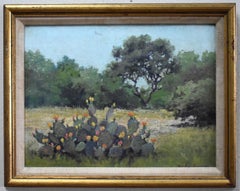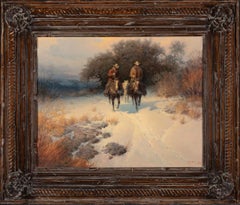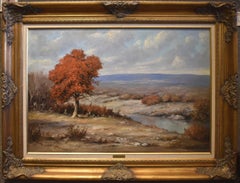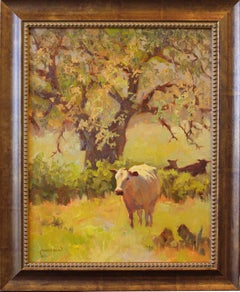Want more images or videos?
Request additional images or videos from the seller
1 of 6
Lucien Abrams"In the Market Place" AlgiersCirca 1880
Circa 1880
$4,500List Price
About the Item
- Creator:Lucien Abrams (1870 - 1941, American)
- Creation Year:Circa 1880
- Dimensions:Height: 12 in (30.48 cm)Width: 14 in (35.56 cm)Depth: 4 in (10.16 cm)
- Medium:
- Movement & Style:
- Period:
- Condition:Please visit our 1stdibs storefront for other goodies.
- Gallery Location:San Antonio, TX
- Reference Number:1stDibs: LU76932575573
About the Seller
5.0
Vetted Professional Seller
Every seller passes strict standards for authenticity and reliability
Established in 1974
1stDibs seller since 2017
102 sales on 1stDibs
Typical response time: 1 hour
Authenticity Guarantee
In the unlikely event there’s an issue with an item’s authenticity, contact us within 1 year for a full refund. DetailsMoney-Back Guarantee
If your item is not as described, is damaged in transit, or does not arrive, contact us within 7 days for a full refund. Details24-Hour Cancellation
You have a 24-hour grace period in which to reconsider your purchase, with no questions asked.Vetted Professional Sellers
Our world-class sellers must adhere to strict standards for service and quality, maintaining the integrity of our listings.Price-Match Guarantee
If you find that a seller listed the same item for a lower price elsewhere, we’ll match it.Trusted Global Delivery
Our best-in-class carrier network provides specialized shipping options worldwide, including custom delivery.You May Also Like
Afternoon Stroll, American Impressionist, Figure on Forest Path, Landscape
Located in Wiscasset, ME
Juliet M. White was born in Philadelphia in 1880. She studied at the Philadelphia School of Design for Women, which became the largest art school for women in the United States. Its ...
Category
20th Century American Impressionist Figurative Paintings
Materials
Canvas, Oil, Board
$2,300
H 16.75 in W 14.75 in
"French Town a Day in Autumn" (2022), Original Landscape Oil Painting on Linen
By Ulrich Gleiter
Located in Denver, CO
Ulrich Gleiter's (EUR based) "French Town, A Day in Autumn" is an original, handmade oil painting on linen, depicting a small French village surrounded by lush forestry and grassland...
Category
2010s Impressionist Landscape Paintings
Materials
Linen, Oil
$3,300
H 27.5 in W 37.5 in
Horizon XI, Oil Painting
By Mandy Main
Located in San Francisco, CA
Artist Comments
Rich reds, golds, and oranges create a minimalist yet dramatic seascape. The panoramic format evokes a sense of vastness and tranquility. Slightly darker edges ...
Category
21st Century and Contemporary Impressionist More Art
Materials
Oil
Antique American Impressionist Coastal Sunset Beach Scene Pointillist Painting
Located in Buffalo, NY
Wonderfully painted sunset coastal beach scene. Framed. Oil on canvas. Image size, 20"H by 24"L.
Category
1940s Impressionist Abstract Paintings
Materials
Canvas, Oil
$1,980 Sale Price
20% Off
H 28 in W 32 in D 2 in
Sur la Plage - Impressionist Oil, Figures in Coastal Landscape by Alfred Stevens
By Alfred Émile Léopold Stevens
Located in Marlow, Buckinghamshire
Signed and dated figures in seascape oil on panel by Belgian impressionist painter Alfred Emile Leopold Stevens. The work depicts an elega...
Category
1890s Impressionist Figurative Paintings
Materials
Oil, Panel
$9,602 Sale Price
30% Off
H 21 in W 17 in
‘Winter’ Snowy Rural Landscape Impressionist Oil Painting
Located in Toronto, ON
Impasto style brushwork brings to life this sketch sized winter landscape. Featuring a rural community weathering a heavy snow fall the focus of this sketch. This highly textured piece captures the feeling of fresh snow drifts on a winters day.
Mostafa Keyhani...
Category
2010s Impressionist Landscape Paintings
Materials
Canvas, Oil
$620 Sale Price
20% Off
H 8 in W 9.5 in
"Rainy Downtown" Contemporary Impressionist Scene of Los Angeles
By Pil Ho Lee
Located in Laguna Beach, CA
"Rainy Downtown" is a dynamic oil that captures the energy and movement of a glistening street scene in downtown Los Angeles, and is an excellent example of Pil Ho Lee's modern appr...
Category
2010s Impressionist Landscape Paintings
Materials
Oil
$1,300
H 12 in W 12 in D 1 in
"Canyon Road" Contemporary Impressionist Scene of Laguna Beach
By Pil Ho Lee
Located in Laguna Beach, CA
"Canyon Road" is a dynamic oil that captures the energy and movement of a glistening street scene in Laguna Canyon, CA, and is an excellent example of Pil Ho Lee's modern approach t...
Category
2010s Impressionist Landscape Paintings
Materials
Oil
$1,300
H 12 in W 24 in D 1 in
Superb French Impressionist Signed Oil Old Provencal Village, Stunning Frame
Located in Cirencester, Gloucestershire
Artist/ School: French Impressionist School, 20th century, indistinctly signed
Title: Provencal country landscape
Medium: signed oil painting on canvas, framed
Size:
framed: 2...
Category
20th Century Impressionist Landscape Paintings
Materials
Canvas, Oil
$2,481
H 23.5 in W 27.5 in
1930's Vintage French Oil, The Provencal Country House & Gardens
Located in Cirencester, Gloucestershire
Artist/ School: French School, 1930's
Title: The Country House and Gardens, Provence
Medium: oil painting on board, framed no signature
framed: 19 x 22 inches
canvas: 15 x 1...
Category
Early 20th Century Impressionist Landscape Paintings
Materials
Oil
$987 Sale Price
20% Off
H 19 in W 22 in
More From This Seller
View All"PRICKLY PEAR" TEXAS HILLCOUNTRY
Located in San Antonio, TX
Dorothy Johnson
Image Size: 12 x 16
Frame Size: 14.5 x 18.5
Medium: Oil
"Prickly Pear"
Category
20th Century Impressionist Landscape Paintings
Materials
Oil
G. Harvey "The New Filly" Western Snow Scene, Cowboys, Horses 36 x 42 framed
By G. Harvey
Located in San Antonio, TX
G. Harvey (Gerald Harvey Jones)
(1933-2017)
San Antonio, Austin, and Fredericksburg Artist
Image Size: 24 x 30
Frame Size: 36 x 42
Medium: Oil on Canvas
1975
"The New Filly"
Mr. Ger...
Category
Early 2000s Impressionist Landscape Paintings
Materials
Oil
"TEXAS AUTUMN" TEXAS HILL COUNTRY ROBERT WOOD
By Robert W. Wood
Located in San Antonio, TX
Robert Wood (G. Day)
(1889 -1979)
San Antonio Artist
Image Size: 24 x 36
Frame Size: 34 x 46
Medium: Oil on Canvas
"Texas Autumn"
Biography
Robert Wood (G. Day) (1889 -1979)
A painte...
Category
20th Century Impressionist Landscape Paintings
Materials
Oil
"SPRING IN HER STEP" TEXAS CATTLE FREDERICKSBURG 22 X 18 FRAMED OPA Member. COW
Located in San Antonio, TX
Chuck Mauldin
Born 1949
Fredericksburg Artist
Image Size: 18 x 14
Frame Size: 22 x 18
Medium: Oil
"Spring In Her Step" Cattle Landscape Texas
A native of Texas, Chuck Mauldin has been painting in oil since the age of twelve. His interest in watercolor and pencil drawing grew during his years spent in Louisiana. With his move back to Texas, he has renewed his focus on oil painting, using this medium in a realistic yet painterly style. Striving to quickly capture color and mood with a direct "alla prima" technique is one of his main objectives in painting outdoors on-location. Cows, cowboys and Native Americans often enrich the landscape in his studio work, while anything can inspire his plein air paintings.
Workshops with Charles Sovek, Kevin Macpherson, and many others have played a significant role in his development as an artist. He is a member of Oil Painters of America and has achieved Signature membership status in the Louisiana Watercolor Society and the Plein Air Artists of Colorado. Chuck has won numerous awards and has had work accepted into prestigious national juried competitions, such as the Oil Painters of America National Show (2020, 2021), Western Regional Show (2016, 2021, 2022) and Salon Show (2016, 2020).
After 28 years in Louisiana, Chuck and his wife, Barbara, moved to Fredericksburg, Texas, in 2005, in order to pursue their passion for art on a full-time basis. In 2008, Chuck started teaching a beginner’s oil painting class and later intermediate classes in composition, landscape painting, and limited palettes. He is represented by Charles Morin Fine Art in Fredericksburg, Texas.
Degrees in chemistry from Southern Methodist University (B.S.) and the University of Texas (PhD) led to Chuck's career in research at ExxonMobil Process Research Labs in Baton Rouge, Louisiana. He presently holds 57 U.S. patents in the field of catalysis. He and Barbara have two sons and a daughter, and 8 perfect grandchildren. An Eagle Scout...
Category
2010s American Impressionist Landscape Paintings
Materials
Oil
"KENDALL COUNTY RANCH" BLUEBONNET LONGHORN FRAMED 53 X 73
By Eric Harrison
Located in San Antonio, TX
Eric Harrison
(Born 1971)
Texas Hill Country Artist
Image Size: 40 X 60
Frame Size: 53 x 73
Medium: Acrylic
2015
"Kendall County Ranch" Longhorn Bluebonnet
Eric Harrison (Born 1971) Texas Hill Country Artist Bluebonnet painting...
Category
2010s Impressionist Landscape Paintings
Materials
Oil
"BARN TO LAST" TEXAS LANDSCAPE NEAR FREDERICKSBURG 21 X 25 FRAMED OPA Member
Located in San Antonio, TX
Chuck Mauldin
Member OPA
Born 1949
Fredericksburg Artist
Image Size: 14 x 18
Frame Size: 21 x 25
Medium: Oil
"Barn To Last" Texas Farm Scene
A native of Texas, Chuck Mauldin has been painting in oil since the age of twelve. His interest in watercolor and pencil drawing grew during his years spent in Louisiana. With his move back to Texas, he has renewed his focus on oil painting, using this medium in a realistic yet painterly style. Striving to quickly capture color and mood with a direct "alla prima" technique is one of his main objectives in painting outdoors on-location. Cows, cowboys and Native Americans often enrich the landscape in his studio work, while anything can inspire his plein air paintings.
Workshops with Charles Sovek, Kevin Macpherson, and many others have played a significant role in his development as an artist. He is a member of Oil Painters of America and has achieved Signature membership status in the Louisiana Watercolor Society and the Plein Air Artists of Colorado. Chuck has won numerous awards and has had work accepted into prestigious national juried competitions, such as the Oil Painters of America National Show (2020, 2021), Western Regional Show (2016, 2021, 2022) and Salon Show (2016, 2020).
After 28 years in Louisiana, Chuck and his wife, Barbara, moved to Fredericksburg, Texas, in 2005, in order to pursue their passion for art on a full-time basis. In 2008, Chuck started teaching a beginner’s oil painting class and later intermediate classes in composition, landscape painting, and limited palettes. He is represented by Charles Morin Fine Art in Fredericksburg, Texas.
Degrees in chemistry from Southern Methodist University (B.S.) and the University of Texas (PhD) led to Chuck's career in research at ExxonMobil Process Research Labs in Baton Rouge, Louisiana. He presently holds 57 U.S. patents in the field of catalysis. He and Barbara have two sons and a daughter, and 8 perfect grandchildren. An Eagle Scout...
Category
2010s American Impressionist Landscape Paintings
Materials
Oil
Recently Viewed
View AllMore Ways To Browse
Lin Hongdan
Lindstrom Painting
Marthas Vineyard Painting
Moonlight Sonata
Oil City Rain
Oil Paintings Cape Cod
Oil Pastel Paintings Sunsets
Pafa Artists
Painting Germany Lake
Paintings Of Hawaii
Paris Painting Winter
Piet Oudolf
Precisionist Painting
River Landscape With Cottage
River Wye
Robin Smith
Rough Seas Painting
Salmon Oil Painting



